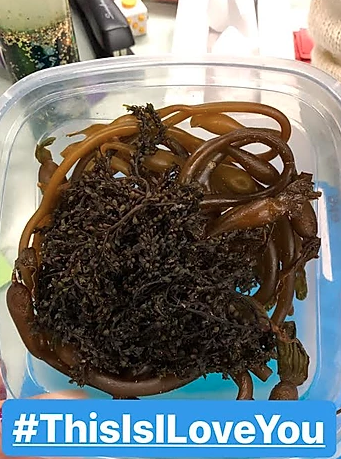My friend once told me about an experience she’d had while working as an in-home behavior therapist that left her feeling extremely disheartened. She had just wrapped up a session with a nonverbal child with autism that had gone smoothly, and was now updating mom on progress. As they chatted, the mom became increasingly emotional. She looked at my friend and said, “I’m afraid my child will never be able to tell me he loves me.”
Hearing this, I felt equally sad for the mom and child. I thought of all of the children and adults with disabilities who I’ve met while working in the realm of in-home behavior therapy and special education. These are individuals with mild to severe behaviors, varied cognitive and physical abilities, and a diverse range of interests. Some engage in typical conversation, some use AAC devices, and some speak ASL. Some need guidance with the development of social skills, while others require assistance with a range of daily tasks. Many of them do express love by saying, “I love you,” and many of them do not.
Still, does that mean that those who don’t say “I love you,” aren’t feeling and expressing love? Of course not! Individuals with disabilities are expressing their love — towards their parents, caregivers, teachers, friends, pets, and everything in between — using countless variations of communication all the time! It’s up to us to recognize, honor, and accept that love.
Let’s switch gears for a moment and imagine a soldier has returned from active duty with injuries that have affected his brain so severely, his speech is unintelligible for the foreseeable future. His spouse arrives at the hospital and is told he’s resting in bed with his head bandaged and only his eyes visible. She walks into his room, gently grabs hold of his hand, and they lock eyes. Instantly, she knows —although he’s unable to say the words “I love you” aloud — he’s communicating his love with every fiber of his being. He’s saying, “I love you” through his eye gaze, the way he squeezes her hand tightly, and the way he embraces her in a hug. It’s in times like these that we don’t get caught up in the how love is expressed because when we’re tapped into the other person’s mode of expression, we intuitively know the love is there.
What if we applied this same intuitive knowing when it comes to understanding the love expressions of individuals with disabilities? Because frankly, I’ve seen some thoughtful, adorable, creative, and hilarious nonverbal love expressions that the rest of us could take notes on.
Here are just a few of the nonverbal love expressions from individuals with disabilities that I’ve been lucky enough to witness or be on the receiving end of:
- A nonverbal child with oral-motor difficulties walking up to his mom to put his lips on her cheek, symbolizing a kiss.
- A child with autism saving a seat at the lunch table for his girlfriend every day, even if it required eating one-handed so that his other hand was on the bench at all times until she arrived.
- A nonverbal child reaching out his hand to hold, then mouthing the word “cheese” and looking at me with his best camera smile.
- A nonverbal child handing his dad his favorite book to read aloud for bedtime, then reaching out his hand so they could walk together to his bedroom.
- A child with a speech impairment pointing to her heart and smiling whenever she felt happy.
- Clapping, jumping, and smiling whenever you’re in proximity.
- Hearing you say you like apples, then picking all the apples off the garden tree and putting them on your desk.
- Choosing to be next to you on the bus, in the car, on an amusement park ride, at a restaurant, etc…just wanting to be near you. And for those that prefer more personal space, taking the time to let their caregivers or parents know where they’re choosing to sit.
- Asking you (through gestures, visual cues, touch, etc.) to watch a video, read a story, or to look at their watch, plush toys, trains, or other treasured collections.
- Giving you hugs, drawings, caterpillars, stickers, thumbs up, high-five’s, kisses, shoulder taps, smiles, hand squeezes, and anything you know serves as a symbolic gesture and glimpse into their unique world.
- A student with autism bringing her 1:1 aide a container full of seaweed because she knows how much she loves the beach.

Nonverbal love expressions like the ones above span across all major forms of nonverbal communication. There’s been an increasing number of studies in recent years recognizing the significance of nonverbal communication as a means for us to relate to the world and others. VeryWellMind.com says, “Every day we respond to thousands of nonverbal cues and behaviors, including postures, facial expressions, eye gaze, gestures, and tone of voice.”
The fact that we are constantly giving and receiving nonverbal communication is so significant, especially when it comes to better understanding our loved ones with special needs who are nonverbal or have difficulties communicating emotions. Dr. Gary Chapman, author of the best-selling book “The Five Love Languages” teaches that there are five main ways of expressing love: words of affirmation, acts of service, receiving gifts, physical touch, and quality time. These love languages are no different when it comes to those with disabilities. In Chapman’s wise words, “Each person has a primary love language that we must learn to speak if we want that person to feel loved.” His principles have helped relationship dynamics in romantic partnerships, families, the workplace, and even the classroom setting.
When we begin to see that individuals with disabilities are constantly communicating to us through their own love language, it will no longer matter how they are saying “I love you.” What will matter is that we are honoring, appreciating, and accepting their love language and ways of saying “I love you” as the meaningful expressions that they are. We do this by increasing our efforts to see the world through their eyes, by choosing to remain open to the ways they communicate with us, and by realizing that there is and never has been one “right” or “best” way to communicate, especially when it comes to expressing love.
Do you have nonverbal love expression stories of your own? We’d love for you to tell us about them in the comments.
A version of this story originally appeared on firstthenandbeyond.com.
Photo submitted by contributor.

